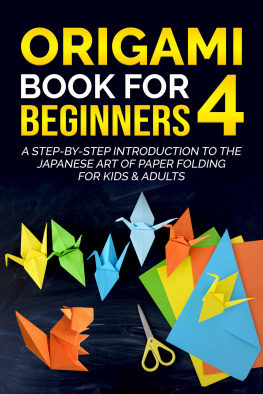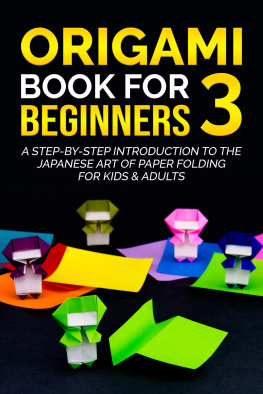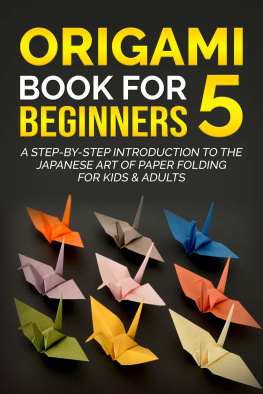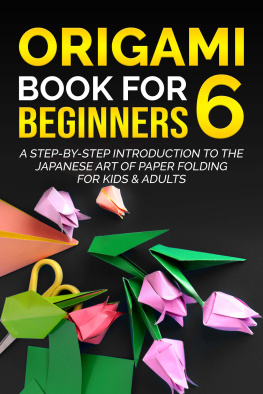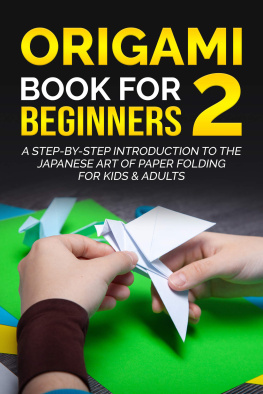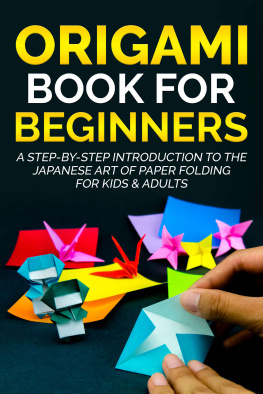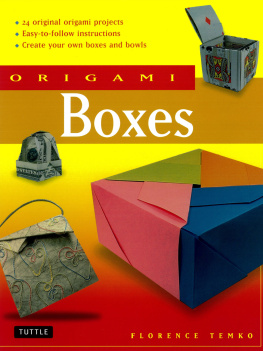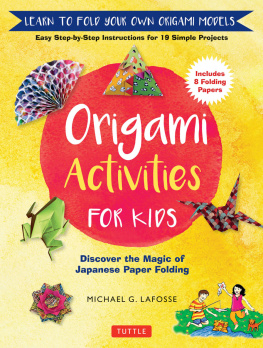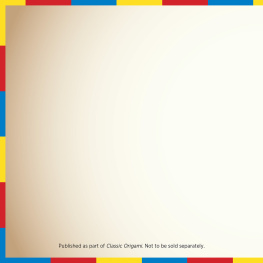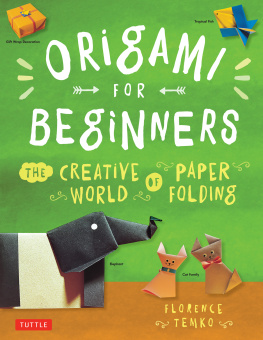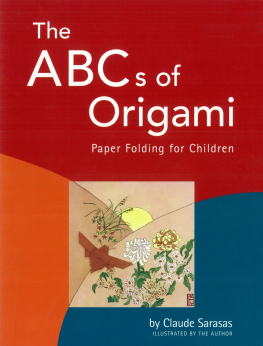Origami Book
for Beginners
Learn How To Create
Beautiful Origami Figures
Step by Step
for Kids & Adults
Copyright - All rights reserved.
The content contained within this book may not be reproduced, duplicated or transmitted without direct written permission from the author or the publisher. Under no circumstances will any blame or legal re- sponsibility be held against the publisher, or author, for any damages, reparation, or monetary loss due to the information contained within this book, either directly or indirectly.
Legal Notice:
This book is copyright protected. It is only for per- sonal use. You cannot amend, distribute, sell, use, quote or paraphrase any part, or the content within this book, without the consent of the author or publisher.
Disclaimer Notice:
Please note the information contained within this document is for educational and entertainment purpo- ses only. All effort has been executed to present ac- curate, up to date, reliable, complete information. No warranties of any kind are declared or implied. Readers acknowledge that the author is not engaged in the ren- dering of legal, financial, medical or professional advi- ce. The content within this book has been derived from various sources. Please consult a licensed professional before attempting any techniques outlined in this book.
By reading this document, the reader agrees that under no circumstances is the author responsible for any los- ses, direct or indirect, that are incurred as a result of the use of the information contained within this document, including, but not limited to, errors, omissions, or inac- curacies.
Table of Contents
Introduction
What is Origami
A quick History of Origami
Paper Folding in Europe
Modern Origami
Symbolism in Origami
Boxes and Envelopes
Samurai Helmets
Tsuru
Tatsu
Neko
Kaeru
Chocho
Symbols
Folds
Model List
Pheasant
Crab
Eagle
Monkey
Jet
Sheep
Clam
Rose
Chicken and chick
Flower
Spaceplane
Bat
Dress
Introduction
Origami is an ancient art form with a history as old and rich as the paper it is made of. As paper evolved and became more refined, so did the art of origami, and as the art grew, it became more popular and spread across the entire world. While cultures all over the world have their own forms of paper folding art, the Japanese art of origami is the art form that has become the most popular and taken the world by storm.
Origami can be as simple or complex as the artist wishes. Designs like a plain, simple heart or dog can be a great introduc- tion to the art for children who, as they progress, may move on to something that takes a little more skill like a paper crane or rhinoceros. Dedicated artists can learn to form gorgeous master- pieces, like an intricate Chinese dragon with individual scales, all folded from a single piece of paper. This is a great art to learn, as the ease with which you can get started is great for be- ginners. Not to mention that it is one of the most affordable art forms available since even if you cant get your hands on proper origami paper, you can still get a lot of practice done with any paper youve got around the house or office.
Origami is a wonderful art form, and understanding a little more about where it comes from can help you appreciate it on a deeper level.
What Is Origami?
In truth, the name says it all. The word origami is built up of two Japanese words: oru , which translates to to fold , and kami , which translates to paper . As such, origami is the art of folding animals, flowers, figures, boxes, trees, etc. out of pa-
per. An important element of origami is that the paper isnt cut or torn in any way. The paper also cant be glued or taped down to hold any edges or corners in place. Instead, clever folds and tucks are used to do that. Traditionally, each origami figure is folded using a single piece of paper, but more modern designs have incorporated ways to fold two or three pieces together for a larger project. It is also traditional not to make any marks on the origami with a pen or pencil, either to mark fold lines or as decoration. True origami paper also has one blank side and one colored side, but you can still use any paper you like as long as it suits your needs.
A Quick History of Origami
The exact origin of paper folding as an art form, in gene- ral, is not certain, and many believe the origins to be older than paper itself when decorative folding techniques were applied to other pliable materials like silk and leather. When paper was first created in China in AD, it was discovered to be the per- fect material for folding: more loose and flexible than leather, and thus capable of much finer detail, but sturdier than silk and capable of holding its shape much better. Somewhere between the sixth and seventh century, this art was brought to Japan and the seeds of origami were sown. Known as origata at the time, the art of paper folding was an exclusive ritual performed by the samurai and holy men and women, due to the rarity of paper. As an element of Shint rituals, decorative boxes and envelopes were folded out of paper and used to wrap offerings given to the gods. It also became popular to use origata to present betrothal and wedding gifts.
In the Edo period, from 1603 to 1868, handmade washi pa- per became more readily available and allowed paper folding to become a popular hobby among the commoners, for both adults
and children. This more common and less ritualistic form of paper folding became known as origami. Other than just a fun way to pass the time, commoners used origami as a cheap, easy way to decorate their homes and gifts. As with most elements of Japanese art, it was most common to fold origami figures that resemble elements of nature, such as animals, plants, and even floral patterns. Origami became so popular during this time pe- riod that it was incorporated into other forms of art, and there were even entire paintings depicting women folding origami in their homes.
Initially, the figures folded were fairly simple and easy, but as the art was practiced, more techniques and more intricate designs were discovered and shared. During this time, the art developed into a tradition and a part of the culture with a dee- per meaning. The cultural significance associated with certain animals and other symbols and figures were transferred to their origami counterparts, and even different types of folds were gi- ven some significance. In 1797, a book called Hiden Senbazuru Origata , or The Secret of Folding 1000 Paper Cranes , was pu- blished by Akisato Rito, in which he explains the cultural sig- nificance of the art and introduces different ways of folding paper cranes. This was the first ever written record of the art.
In 1954, the traditional art of origami was revolutionized when Akira Yoshizawa published a book called Atarashi Ori- gami Geijutsu , which translates to The New Origami Art . In this book, the author not only introduced the concept of using ori- gami as an educational tool to help teach children certain basic math concepts, but he also used new patterns that encouraged origami artists to cut, tear, wet, and glue the paper to make in- tricate new figures. With these new origami designs, the artists were no longer restricted to using only one square piece of paper, and the art form enjoyed a new surge in popularity. This book
also helped spread the art form to the rest of the world and turn the Japanese art of paper folding into a worldwide sensation.

